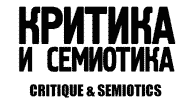Philosopher in the city: Kant and Königsberg
DOI: 10.23951/2312-7899-2025-2-72-104
The article is a continuation of a series of works on the mutual influence of man and city using the example of the intertwining of biographies of a philosopher and a city. This work shows how the city of Königsberg influenced the formation of the personality and biography of the philosopher Kant, and how the name of the philosopher Kant subsequently began to influence the biography of the city. The author believes that the key features of a city are how urban communities are formed in it, how the forms of sociability created and generated by the city influence the philosopher’s way of thinking and actions, and then how the philosopher himself shapes urban forms of life with his actions. The article shows that philosophy is a public urban action, carried out not in the private space of an office, but in public places, which was clearly shown by Kant himself, who actually became the forerunner of the urban flaneur and the organizer of urban club forms of sociability.
Keywords: city, image of city, genius loci, form of urban space, Königsberg, Kaliningrad, Kant, philosophy, biography, club
References:
Bojanić, P. (2017). Public biased urban philosopher. Should philosophy be only urban (philosophy of the city)? Vestnik of Saint-Petersburg University. Philosophy and Conflict Studies, 33(1), 4–13. (In Russian).
Brodsky, J. (1992). Works. Pushkin Foundation. (In Russian).
Drury, M.O’C. (1999). Conversations with Wittgenstein. Logos, 1(11), 131–150. (In Russian).
Gause, F. (1974). Kant und Königsberg. Gerhard Rautanberg.
Gavrilina, L. M. (2010). The Kaliningrad text as a metatext of culture. Kantian Journal, 3(33), 64–79. (In Russian).
Heller, A. (1992). Immanuel Kant invites to dinner. Voprosy Filosofii, 2, 129–138. (In Russian).
Horst, G. (2009). Kant as a resident of East Prussia. https://213df7ed-791b-465b-91ee-46698c5ed859.filesusr.com/ugd/e49178_d714ca738f014df6ae0968313bca0eb3.pdf (Accessed: 09.08.2024). (In Russian).
Horst, G. (2015). Hannah Arendt and Königsberg. In The modern meaning of Hannah Arendt’s Ideas (pp. 86–102). Immanuel Kant Baltic Federal University Press. (In Russian).
Immanuel Kant in Kaliningrad. Guide. (2024). Pictorika. (In Russian).
Kant, I. (1996a). Works in six volumes. Vol. 5. Mysl’. (In Russian).
Kant, I. (1996b). Works in six volumes. Vol. 6. Mysl’. (In Russian).
Karl, G. (1924). Kant und Alt-Königsberg. (A. N. Khovansky, Trans.). Bitekar. (In Russian).
Krouglov, A. N., Salikov, A. N., & Zhavoronkov, A. G. (2023). Kant’s εarly biographies and τheir significance for understanding his philosophy. History of Philosophy Yearbook / Istoriko-Filosofskii Ezhegodnik, 38, 205–252. (In Russian).
Kuhn, M. (2021). Kant: A biography (A. Vasil’eva, Trans.). Publishing House “Delo” of RANEPA. (In Russian).
Kuznetsova, I. S. (2012). Immanuel Kant. Immanuel Kant Baltic Federal University Press.
Lotman, Yu. M. (1996). Inside thinking worlds: Man – text – semiosphere – history. Yazyki russkoy kul’tury. (In Russian).
Motroshilova, N. V. (2014). Immanuel Kant: Everyday life, Tischgesellschaft in unity with philosophy in the Age of Enlightenment. https://freunde-kants.wixsite.com/freunde-kants-ru/n-v-motroshilova-immanuil-kant-1 (Accessed: 09.08.2024). (In Russian).
Piatigorsky, A. M. (2014). Philosophical prose. Vol. 3. Ancient Man in the City. NLO. (In Russian).
Popadin, A. (2010). Local time 20:10. Walking around Kaliningrad. Zapadnaya pressa. (In Russian).
Rumyantseva, T. G. (2023). Königsberg city as a factor in the development of Kant-Philosopher. Urbis et Orbis. Microhistory and Semiotics of the City, 3(2), 226–233. (In Russian).
Rzhevsky, V. (2019). Blazing Hell: How Königsberg was bombed in August 1944. https://www.kaliningrad.kp.ru/daily/27020/4083787/ (Accessed: 09.08.2024). (In Russian).
Smirnov, S. A. (2020). City and man. Essays on urban anthropology. Lenand. (In Russian).
Smirnov, S. A. (2021). Scientific communities: From the circle to institution (Based on the material of scientific schools in philosophical sciences). Filosofiya Nauki, 3(90), 48–75. (In Russian).
Stavenhagen, K. (1949). Kant und Königsberg. Deuerlich.
Svetlov, R. V. (2021). Philosopher on the streets of the city. In Educational Spaces and Anthropological Practices of the City (pp. 216–229). Akvilon. (In Russian).
Toporov, V. N. (1993). Petersburg and Petersburg text of Russian literature. In Metaphysics of Petersburg. Petersburg Readings on Theory, History and Philosophy of Culture (is. 1, pp. 205–235). Eidos. (In Russian).
Wasianski, E. A. Ch. (2012). Immanuel Kant in seinen letzten Lebensjahren. Kantian Journal, 1(39), 55–61. (In Russian).
Zilber, A. S. (2014). Kant studies In Königsberg: 1784–1948. Kantian Journal, 3(49), 92–122. (In Russian).
Zorin, V. (2006). Dreams about Königsberg. In Anthology of Kaliningrad stories (pp. 169–181). Kladez’. (In Russian).
Issue: 2, 2025
Series of issue: Issue 2
Rubric: ARTICLES
Pages: 72 — 104
Downloads: 581










